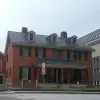Long before European colonists arrived, the land that is now Butler County, Pennsylvania, was under the control of the Iroquois Confederacy. This changed in 1753, when the French began establishing a series of forts in the region, culminating in the French and Indian War. After the American Revolution, the fledgling U.S. government—unable to compensate soldiers with money—offered land patents in this area as an alternative to pay, sparking new waves of settlement.
Founded in 1927, the Butler County Historical Society was created with a mission to preserve and celebrate the rich history and cultural heritage of Butler County. That same year, a group of residents gathered to explore how they could contribute to safeguarding their community's story. Their efforts laid the foundation for what would become a decades-long endeavor to document and showcase the county's past.
For over 20 years, county residents have envisioned a dedicated space to display artifacts and memorabilia that represent Butler's industrial and agricultural legacy. That vision became a reality in 1994, when the Society acquired a three-story commercial building in downtown Butler. One year later, the Heritage Center opened its doors, offering 4,500 square feet of exhibit space.
Among the highlights of the permanent collection are:- An original Bantam "jeep"
- The Bantam Hollywood prototype convertible sports car
- Exhibits that chronicle the evolution of key local industries
In addition to exhibitions, the Heritage Center welcomes business meetings, family reunions, motorcoach tours, and club outings by prior arrangement.

Tours $5.00 Per Person
$4.00 Seniors/Military Personnel
Free for BCHS Members and Children under 5


